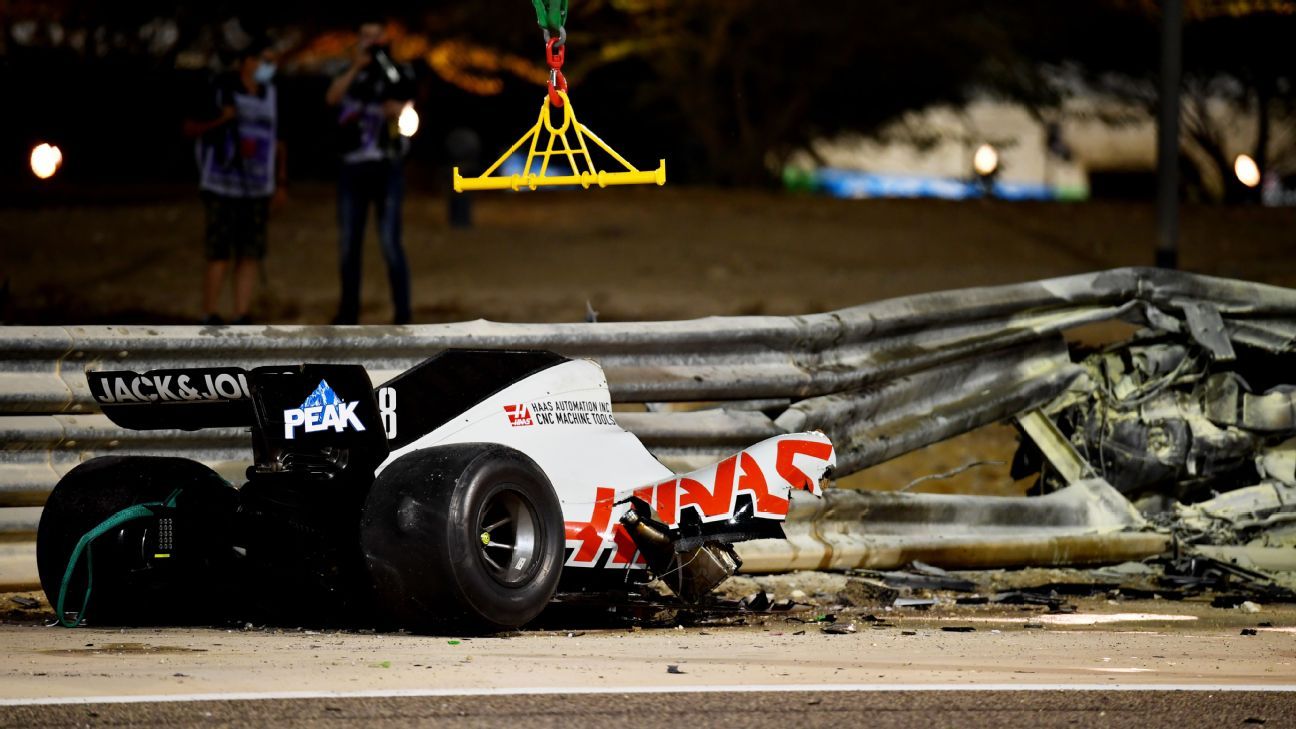

It is been 5 years for the reason that 2020 Bahrain Grand Prix, the place Romain Grosjean suffered a frightening crash. Clive Mason – System 1/System 1 by way of Getty Pictures
Romain Grosjean’s fiery crash on the Bahrain Grand Prix 5 years in the past stays some of the surprising in System 1’s historical past.
It created some of the memorable photographs of contemporary F1, with the then-Haas driving force rising from the flames after 27 seconds trapped within the automotive. Remarkably, given the severity of the crash, the Frenchman suffered burns on his palms however no different accidents.
Grosjean’s survival gave the impression to defy common sense. He had crashed closely, at top pace, and his automotive had cut up in two. His automotive had erupted into flames, and he had spent an impossibly very long time within the burning wreckage. It was once a crash and a survival that shined a mild at the F1 protection inventions which have been saving lives for years.
The crash
On Lap 1, Grosjean tangled with Daniil Kvyat as the 2 drove clear of the chicane that opens the Bahrain Sakhir circuit. Grosjean’s automotive was once pitched to the fitting, head-first into the limitations. The auto itself was once torn in two: the entrance part went in the course of the guardrail, right into a mangled mesh of carbon fiber, whilst the again part was once despatched careening additional alongside the limitations. The auto straight away burst into flames.
The FIA’s investigation into the crash later decided that Grosjean hit the barrier at 192 kph (119 mph), at an estimated yaw of twenty-two levels from the traditional path of shuttle. The consequent top drive was once similar to 67 Gs. To place that into standpoint, a driving force reports round 6 Gs when hitting a heavy braking level from best pace.
Grosjean was once ready to get out of the auto unaided. As he did so, F1’s clinical automotive had already arrived at the scene, with Dr. Ian Roberts there to assist pull Grosjean to protection. It was once a scarcely plausible visible second, however the Frenchman’s survival, his emergence from the flames, was once credit score to a couple of technological inventions pioneered through the FIA and F1 in contemporary a long time.
Editor’s Selections
2 Comparable
Because it grew to become out, Grosjean’s existence was once stored a couple of instances in a fragment of a moment through a lot of items of tech.
The carbon-fiber cocoon
The obvious position to begin was once the survival mobile. Sometimes called the monocoque, this has change into some of the important bits of protection apparatus in System 1 these days. It’s been not unusual for the reason that early Nineteen Eighties, having first been pioneered on John Barnard’s McLaren in 1981.
The crash assessments that groups go through forward of the season center of attention in this a part of the auto, and these days, the monocoque is the closing defensive line between the driving force and the monitor. It has most likely stored extra lives than it’s been given credit score for.
Sooner than the emergence of the carbon-fiber monocoque, the cockpit round Grosjean’s automotive would were mincemeat. In all probability, his legs and torso would were the principle surprise absorber in this sort of crash.
Constructed like a cocoon, the monocoque is produced from woven carbon fiber and resin, designed to be unbreakable. Grosjean’s crash was once the most productive instance of that, staying intact within the just about 67 G affect, although the Haas VF-20 itself cut up in part. Grosjean had remained firmly inside the protection mobile, his frame safe from primary accidents.
HANS tool
As Grosjean’s automotive went in the course of the motions of speedy deceleration related to such affects, every other innovation kicked in.
The top and neck improve (HANS) tool, worn round driving force’s necks, may seem bulky when drivers first pull themselves out of the cockpit, however its position is very important. The HANS tool necessarily prevents speedy or out of control actions of the top, combating whiplash, or worse. In a crash involving the ones sorts of forces, the HANS tool can save you damaged necks and cranium fractures.
Romain Grosjean’s helmet is displayed, showcasing the after results of his fiery crash 5 years in the past in Bahrain. MAZEN MAHDI/AFP by way of Getty Pictures
The HANS was once no longer roundly embraced when offered — infamously, Dale Earnhardt’s loss of life on the 2001 Daytona 500 accelerated its acceptance as an crucial a part of a race cockpit. With Grosjean’s legs and torso stored protected through the survival mobile and his neck safe through the HANS tool, every other once-maligned little bit of generation emerged in what may were its best hour.
Halo: skeptic to believer
Most likely probably the most important protection innovation of System 1’s contemporary historical past, the Halo cockpit tool essentially modified the game. Since its inception in 1950, F1 automobiles had featured open cockpits. The rush for added driving force coverage won pace in 2009 when Henry Surtees was once killed through a flying tire in a System 2 race, in a while ahead of Felipe Massa suffered a life-threatening damage when a free coil spring struck his head throughout follow for the Hungarian Grand Prix.
The 7 kilogram titanium tool was once designed to resist 12 lots of drive. Within the lead as much as the halo’s advent in 2018, the FIA said it’s good to drop certainly one of London’s well-known crimson buses on best of it and it could no longer destroy. The tech cut up opinion. Grosjean was once a fierce critic, pronouncing “I do not believe it has a spot in F1.”
On that day in Bahrain, the halo proved important. Within the pre-halo technology, Grosjean’s head would were uncovered to the guardrail his automotive struck at 119 mph. Surely, this was once one side of generation that stored his existence. It was once a seismic second in Grosjean’s view of the tool.
Posting a message from his health center mattress tomorrow, Grosjean wrote: “I wasn’t for the Halo some years in the past, however I feel it is the largest factor that we have now dropped at System 1, and with out it I would not be capable to discuss with you these days.”
LISTEN TO ‘UNLAPPED’

Nate Saunders and Laurence Edmondson geek out about System One and the personalities in the back of it on “Unlapped,” ESPN’s weekly F1 podcast. Concentrate to ‘Unlapped’
Extraction
Underpinning the halo tool is the extraction take a look at. Sooner than the season, all drivers should be capable to unbuckle, transparent the cockpit and get unfastened from the auto in 10 seconds. Grosjean’s real-life take a look at proved to be some slower than that. As his automotive got here to leisure, he had a terrifying realization: he was once trapped within the automotive through his left boot. Surrounded through flames and disorientated, his foot would no longer come free till he compelled it out of his boot.
Given the cases, it is possibly unsurprising that it took him 3 makes an attempt to climb out of the auto, however the choreography of the extraction is drilled into drivers such a lot that it has change into moment nature. Grosjean continued 28 seconds, no longer 10, and nonetheless made it out alive.
Hearth coverage
Visually, probably the most surprising a part of the crash was once the huge fireball that erupted as the auto tore in the course of the limitations. That Grosjean walked away with most effective burns to his palms was once regarded as a minor miracle. In a long time up to now, drivers suffered horrific fire-related accidents in crashes.
The temperature of the type of blaze Grosjean sat in can vary any place from 800 levels Celsius to at least one,000. The Haas driving force was once dressed in an Alpinestars swimsuit fabricated from Nomex, a flame-resistant subject material utilized in racing overalls for many years.
A brand new swimsuit design have been pioneered for the 2020 season, with a trust that the garment may save you critical accidents from such excessive temperatures for round 18 seconds. Grosjean’s 27 seconds within the automotive a ways exceeded that benchmark. In 2021, the FIA pioneered new gloves, having recognized that house as some of the few closing vulnerable spots that his crash had uncovered. The governing frame has persevered making inroads on this house since.
Seconds subject: The clinical automotive and extraction workforce
System 1 has a abnormal custom, one who in the beginning look may appear misplaced in a game constructed on pace. Originally of each race, there is a street automotive intentionally following in the back of the sphere: the F1 clinical automotive. Pushed through Alan van der Merwe, with Dr. Ian Roberts within the passenger seat, the auto’s activity is inconspicuous: get to any first-lap crash web site as temporarily as conceivable.
That quirk could have stored Grosjean’s existence.
The instant his automotive disappeared in a burst of orange flame, the clinical automotive sped up. Inside 11 seconds, Van der Merwe was once parked through the wreckage. Roberts ran towards the inferno with a hearth extinguisher, unaware if the driving force within was once nonetheless alive. When Grosjean gave the impression, mountain climbing from the hearth, Roberts helped drag him clear of the wreckage.
Round them, marshals doused the realm with extinguishers, giving the scene a surreal, virtually theatrical haze. There was once no efficiency, although, simply split-second motion that stored a existence.






